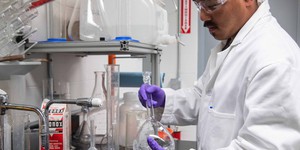Abstract
There's nothing quite like the smell of fresh-baked muffins for breakfast on a Saturday morning! If you're into baking, you might want to try this project, which will give you insight into some of the chemistry that's going on in your muffin batter. You'll get some practical knowledge about substituting ingredients. Who knows, it may even get you started on the path to some new culinary inventions!Summary
Andrew Olson, Ph.D., Science Buddies
Sources
This project was inspired by the following sources:- Helmenstine, A.M., 2007. What Is the Difference Between Baking Powder and Baking Soda? About.com: Chemistry. Retrieved August 25, 2007.
- Manthey, D., 2002. A Comparison of Leavening Agents, Manthey's Baking Page. Retrieved August 28, 2007.
Objective
The goal of this project is to find out if baking soda can substitute for baking powder in a recipe.
Introduction
If you've baked muffins from a mix, you know it's a cinch if you can follow directions. In fact, the same goes for making them from scratch. If you can follow a recipe, you can make great fresh-baked muffins in less than an hour, start-to-finish. That is, if you have all the ingredients. Having to make a trip to the store is a bummer if you're hungry for breakfast. In this project, we'll see if you're doomed to run an errand if you happen to be out of baking powder when muffins are on the morning agenda.
If you examine the texture of a muffin (or a biscuit, pancake, waffle, or slice of bread), you'll see that the basic structure is a random sort of meshwork that surrounds air spaces of various sizes. Without the air spaces, the end result would much more closely resemble a brick than bread. The air spaces are the result of bubbles of gas (mostly carbon dioxide) that are produced within the batter during the baking process. Ingredients that produce these bubbles are called leavening agents.
Muffins are an example of what bakers call a "quick bread" because, unlike a traditional bread dough, there is no yeast used in the recipe and no need to wait hours for the bread dough to rise. In a quick bread, the leavening agent is usually baking powder. Baking powder is a dry mixture that typically contains corn starch (as a filler and to keep the ingredients dry), sodium bicarbonate (a base, also known as 'baking soda'), sodium aluminum sulfate (an acid), and monocalcium phosphate (another acid). When baking powder dissolves in the liquid ingredients in your recipe, the basic component (sodium bicarbonate) can then react with the acidic components (sodium aluminum sulfate and monocalcium phosphate). One of the products of the resulting chemical reaction is carbon dioxide gas, which provides the leavening for the baked product. As the batter is baked, the carbon dioxide produced by the baking powder makes bubbles in the batter. The bubbles expand in the hot oven, and are trapped by the surrounding structure of the batter, mainly supported by proteins in the flour and eggs.
In addition to producing carbon dioxide gas, the base (sodium bicarbonate) and acids (sodium aluminum sulfate and monocalcium phosphate) in baking powder neutralize each other, so that the batter is neither acidic nor basic. Batter that is too acidic would tend to have a sour taste, whereas batter that is basic would tend to taste bitter
You may notice that some baking powders (like the one described above) are called "double-acting." This is because one of the acidic components (sodium aluminum sulfate) reacts more slowly with the sodium bicarbonate. The reaction of sodium bicarbonate with the other acidic component of baking powder, monocalcium phosphate, is faster. The idea behind double-acting baking powder is that a greater proportion of the baking powder reaction (and hence carbon dioxide production) will happen during baking in the oven, rather than while you are still stirring the batter. In theory, this should mean more air spaces in the final baked product (i.e., higher rising, fluffier baked goods) with double-acting baking powder than with single-acting baking powder. (See the Variations section for a related experimental suggestion.)
So what would happen if you discovered that you were out of baking powder, but that you had a whole box of baking soda handy? Could you still find a way to make fluffy, tasty muffins? In this project, you'll try making your own baking powder using baking soda and cream of tartar. No, this isn't tartar sauce! Cream of tartar (also known as 'potassium bitartrate'), is a byproduct of making wine. It is an acidic powder that can also be used to stiffen beaten egg whites, for example, when making meringue for a pie (Wikipedia contributors, 2007). Can you use cream of tartar and baking soda instead of baking powder? Find out for yourself with this project.
Terms and Concepts
To do this project, you should do research that enables you to understand the following terms and concepts:
- Quick breads (muffins, biscuits, pancakes, waffles)
-
Leavening agents for quick breads
- Baking soda
- Baking powder
- Cream of tartar (potassium bitartrate)
- pH
Questions
- How do leavening agents work for baking?
- What is the difference between baking soda and baking powder?
Bibliography
- For background information on cream of tartar, see:
- Wikipedia contributors, 2007. Potassium Bitartrate, Wikipedia, The Free Encyclopedia. Retrieved August 29, 2007.
- For information on baking powder and baking soda, try these references:
- Wikipedia contributors, 2007a. Baking Powder, Wikipedia, The Free Encyclopedia. Retrieved August 25, 2007.
- Helmenstine, A.M., 2007. What Is the Difference Between Baking Powder and Baking Soda? About.com: Chemistry. Retrieved August 25, 2007.
-
The recipe for cornmeal muffins is from:
Beard, J., 1972. American Cookery Boston, MA: Little, Brown and Company, p. 795. - For an experiment comparing different leavening agents for making biscuits, see:
Manthey, D., 2002. A Comparison of Leavening Agents, Manthey's Baking Page. Retrieved August 28, 2007.
Materials and Equipment
To do this experiment you will need the following materials and equipment:
- Muffin pans
- Optional: paper muffin cups (for lining pan)
- Mixing bowl
- Measuring cups and spoons
-
Muffin ingredients (enough for 4 half-batches, see recipe in Experimental Procedure for more
details):
- Flour
- Corn meal
- Eggs
- Sugar
- Butter
- Baking powder (to make "normal" muffins, for comparison)
- Baking soda
- Cream of tartar (potassium bitartrate)
- Oven
- Oven mitts
- Cooling rack
- Timer
- Kitchen scale is helpful, such as the digital pocket scale from Amazon.com but not absolutely necessary
- Camera is useful for photographing the results for your display board, but again, not absolutely necessary
Disclaimer: Science Buddies participates in affiliate programs with Home Science Tools, Amazon.com, Carolina Biological, and Jameco Electronics. Proceeds from the affiliate programs help support Science Buddies, a 501(c)(3) public charity, and keep our resources free for everyone. Our top priority is student learning. If you have any comments (positive or negative) related to purchases you've made for science projects from recommendations on our site, please let us know. Write to us at scibuddy@sciencebuddies.org.
Experimental Procedure
- Do your background research so that you are familiar with the terms, concepts, and questions, above.
-
Use the muffin recipe below as a starting point (Beard, 1972), or pick your favorite muffin recipe and make a "half batch" of 6-8 muffins. Note: The recipe shown below will make 6-8 muffins. You can "halve" your own recipe by dividing the required amount of each ingredient by two. Be sure and note the ingredient amounts you use!
- 1/2 cup all-purpose flour
- 1/2 cup cornmeal
- 1/2 to 1 tablespoon sugar (to your taste)
- 2 teaspoons baking powder or
- cream of tartar and baking soda (see below for amounts to use)
- 1 egg, slightly beaten
- 1/2 cup milk
- 1/8 cup melted butter
- Mix all of the dry ingredients together in the mixing bowl. Make a well in the center and the beaten eggs, the milk, and the melted butter. Stir to a smooth batter. Fill well-buttered (or paper-lined) muffin pans about two-thirds full. Bake at 425°F for 15-20 minutes, or until nicely browned and baked through.
- Tip: do your best to start each muffin off with the same amount of batter. You can use a teaspoon to move small amounts of batter between the different cups in a pan to get the muffins equalized. On the other hand, you don't want spend too much time on this, because the baking powder starts working as soon as it touches liquid.
- Remember to use oven mitts when putting the pans in the oven and when taking them out again.
- Place the muffin pan on a cooling rack for a few minutes, and then tip the muffins out. Let them cool for a few more minutes before handling (or sampling!) them.
-
Make one half-batch following the baking powder recipe (or your own halved recipe) above, and then four additional half batches, substituting the following amounts of cream of tartar and baking soda:
- 0 teaspoons cream of tartar, 3/4 teaspoons baking soda,
- 1 teaspoon cream of tartar, 1/2 teaspoon baking soda,
- 1 1/2 teaspoons cream of tartar, 3/4 teaspoons baking soda,
- 2 teaspoons cream of tartar, 1 teaspoon baking soda.
- Remember to keep track of which batch is which!
-
Compare the four different half-batches of muffins:
- Measure the height of each muffin in each batch and compute the average height for each batch. Note: if one muffin is much smaller than all the others, don't include it when calculating the average height.
- If you have a kitchen scale, you should also measure the weight of each muffin.
- More advanced students can also calculate the density of each muffin (see the Variations section, below).
- Slice some representative muffins from each batch so that you can compare the texture.
- Although it is definitely not the case for most chemistry experiments, for this one it's OK to do a taste test!
- Tip: for obvious reasons, it's important to do the size and weight measurements before the taste test!
Ask an Expert
Variations
- All of the combinations above had a ratio of two parts cream of tartar to one part baking soda. Is this the ideal amount? Design an experiment to find out the best ratio to use.
- You could also try other acids to activate the baking soda, for example: vinegar or lemon juice. What is the right amount to add? Do they work in combination with baking soda to make the muffins rise? How do they affect the taste of the finished product?
- For a related experiment, see the Science Buddies project Chemistry of Baking Ingredients 1: How Much Baking Powder Do Quick Breads Need?
Careers
If you like this project, you might enjoy exploring these related careers:
Related Links
- Science Fair Project Guide
- Other Ideas Like This
- Cooking & Food Science Project Ideas
- My Favorites
- Chemistry Safety Guide










